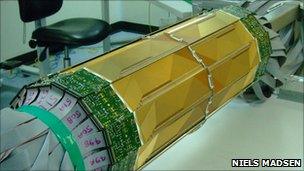Antimatter atoms are corralled even longer
- Published

The team uses an ultra-cold magnetic trap
Scientists have succeeded in trapping atoms of anti-hydrogen for more than 15 minutes.
The feat is a big improvement on efforts reported last year that could corral this mirror of normal hydrogen for just fractions of a second at best.
The researchers tell Nature Physics, external journal that they can now probe the properties of antimatter in detail.
This will help them understand why the Universe is composed of normal matter rather than its opposite.
Matter and antimatter are identical except for opposite charge, and destroy each other when they meet. Theory holds they should have been produced in equal amounts at the Big Bang - and yet the cosmos favoured matter over its mirror.
"We have improved the efficiency of trapping compared with what we published last November," said Jeffrey Hangst, who works on the Alpha collaboration at the Cern particle physics laboratory in Switzerland.
"In order to make these studies, it surely helps to have more atoms and we've made an improvement of about a factor of five. We announced 38 trapped atoms [last year]; we've now studied about 300 which have been held for varying amounts of time."
In normal matter, a hydrogen atom comprises an electron bound to a proton. In the anti-form, the mirror of an electron - a positron - is bound to an antiproton. Together, these two particles make a neutral anti-atom.
Particle physics labs such as Cern can make antimatter particles routinely but until now they have had great difficulty in retaining this material because it will instantly annihilate on contact with conventional containers made of normal matter.
The Alpha collaboration, however, has developed a frigid, evacuated, "magnetic bottle" that allows its scientists to enclose anti-hydrogen particles and draw out the time before they are destroyed. Initially this was a mere two-tenths of a second but the team says it has increased this period more than 5,000-fold.
The significance is that it allows the antiparticles to relax to their ground state.
"If you think of an atom as a little planetary system with the electron orbiting the nucleus - or in our case, a positron orbiting the anti-proton - the ground state is the one where the electron or positron is closest to the nucleus," explained Dr Hangst.
"We think we make our anti-hydrogen in excited states; in other words the positron is at a larger distance from the nucleus. It has more energy. That's not the state we want to study. It takes some fraction of a second for these atoms, once they're produced, to get to the ground state.
"If you hold them 1,000 seconds, you can be quite sure they're in the state you want to study; and this is the first time that anyone can make that claim."
The Alpha team now plans to use microwaves to probe the anti-hydrogen atoms' internal structure.
They would also like to see how these particles behave in the gravitational fields that exist in our "normal Universe".

An artist's conception of an anti-hydrogen atom being released from the trap after 1,000 seconds
This latter experiment will require laser manipulation and even colder conditions. At the moment, the anti-hydrogen atoms are held in their bottle at just half a degree above absolute zero. For the gravity experiments, conditions would need to be a few thousandths of a degree above the theoretically coldest achievable temperature.
"The question is very simple: do matter and antimatter obey the same laws of physics? That's a very simple question, but a very profound one," Professor Hangst told BBC News.
"The Big Bang theory says there should have been equal amounts of matter and antimatter at the beginning of the Universe. Nature kinda 'took a left turn' and chose matter.
"We know that we're missing something from the current model of how the Universe works; we just don't know what that is. So, anytime you get your hands on antimatter you should look very carefully to see if you can find something different."
One task is to increase the number of anti-atoms in the trap. The team says this is more useful now than trying to increase the anti-atoms' longevity which is ample for the planned experiments.
But collaborator Dr Makoto Fujiwara says this could change: "Our current apparatus is not optimised in fact for even longer life-time.
"It's possible that we have them much longer already but it will be limited by the vacuum - the residual gas in the system - and in the future I think we want to optimise that for even better life-times because in some cases we may want to hang on to the antimatter longer."
The Alpha collaboration originally posted news of its 1,000-second confinement earlier this year on the Arxiv repository, external. The research has now been formally published in Nature Physics.
- Published27 April 2011
- Published7 March 2012
- Published12 June 2010